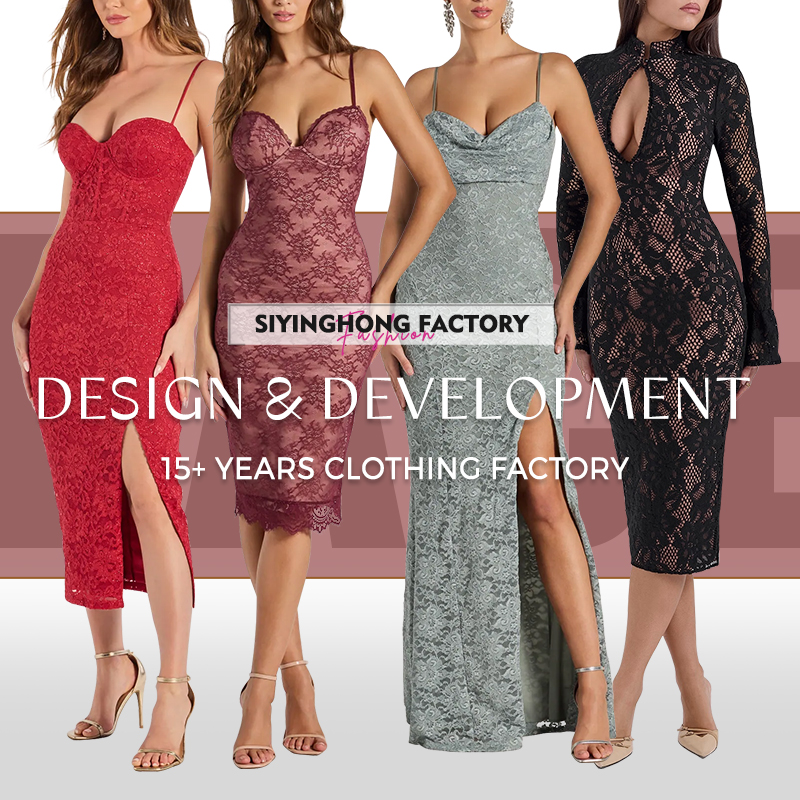1.The definition and historical origin of evening gowns
1) Definition of evening dress:
Evening dress is a formal dress worn after 8 p.m., also known as night dress, dinner dress or ball dress. It is the highest grade, most distinctive and fully showcasing individual style of women's dress. It is often paired with shawls, coats, capes and other clothes, and together with gorgeous decorative gloves and other items, it forms an overall outfit effect.
2) The historical origin of evening gowns
●Ancient civilization period:The origin of evening gowns can be traced back to ancient civilizations such as ancient Egypt and ancient Rome. At that time, the wealthy class would wear magnificent clothes to attend important ceremonies. These clothes were very exquisite in terms of materials and craftsmanship, and were the early prototypes of modern evening gowns.
●Mittelalterliche Warmzeit:In Europe, evening gowns were popular among the nobility and gradually evolved into more exquisite and luxurious styles. At this time, evening gowns were mainly used to highlight the status and position of the nobility, and the design and production of the clothing were very meticulous.
●Renaissance:The braced skirt was widely popular in European women's clothing. Marguerite, the wife of Henry IV of France, changed the conical braced skirt of Spain to add a wheeled braced frame at the waist, making the hip circumference fuller and the waist appear slimmer. At the same time, various tight-fitting clothes also emerged one after another. The characteristics of clothing during this period laid the foundation for the development of evening gowns.
● The 16th - 18th century
☆16th century:Evening long dresses emerged. These were relatively casual and movable clothes worn by noble women in the court in private occasions, with a relatively high degree of exposure. Later, noblewomen wore this kind of informal evening dress to paint portraits and receive people of lower status than themselves, which became a symbol of fashion and power.
☆ 18th century:Evening long dresses gradually became formal gowns and formed different branches from daytime gowns. Lightness and nudity also became the rules and style of evening gowns.
● Late 19th century:
☆Prince Edward of Wales (later Edward VII) wanted an evening dress that was more comfortable than a dovetail coat. In 1886, he invited the New Yorker James Porter to his hunting estate. Porter custom-made a suit and dinner jacket that met the prince's specifications at the London tailor Henry Poole Company. After returning to New York, Porter's dinner suit was popular at the Tuxedo Park Club. This special cut was later called the "tailcoat" and gradually became an important style of men's evening dress.
● The beginning of the 20th century:
☆ Evening gowns began to gain widespread popularity and continued to evolve along with fashion trends, evolving into various styles and designs. They have become essential attire for women attending events such as balls, concerts, banquets, and nightclubs.
2.What are the differences between evening gowns and ordinary dresses?
Evening gowns and ordinary dresses have significant differences in terms of wearing occasions, design details, material craftsmanship, and matching requirements. The following is a detailed analysis of the specific differences:
(1) The occasions and functional positioning of evening gowns/dresses
Elaborate on the positioning of evening gowns and ordinary dresses according to the occasion and the nature of social interaction from two dimensions respectively:
●Occasion attribute:
1)Evening dress: Specifically designed for formal evening occasions (such as banquets, balls, award ceremonies, high-end cocktail parties, etc.), it is a ceremonial dress that should conform to the solemnness and social norms of the occasion.
2)Dress: suitable for daily commuting, leisure, shopping and other party everyday scenarios, function is given priority to with comfortable, practical, low demands on occasion etiquette.
●Social significance:
1)Evening dress: It is a symbol of status and taste. One needs to show respect for the occasion through dressing and even become the focus of social occasions (such as red carpet gowns).
2) normal dress: pay more attention to express personal style, comfortable as the core, need not bear the ceremonial social function.
3.The design styles and detailed differences of evening gowns/dresses
1) Style and Outline
Evening dress:
● Classic styles: such as floor-length skirts (with floor-length skirts), A-line puffed skirts (with crinoline), slim-fitting fishtail skirts, etc., emphasizing the elegance and presence of lines, often featuring backless, deep V-neck, one-shoulder and other sexy designs (but they need to be appropriate for the occasion).
● Structural features: The waist is often cinched, highlighting the curve. The skirt hem may incorporate layered chiffon skirts or slits (such as side slits or front slits) to enhance the dynamic beauty when walking.
Ordinary dress:
● Diverse styles: including shirt dresses, halter dresses, shirt collar dresses, sweatshirt dresses, etc. The silhouettes are more casual (such as straight, O-shaped), and the lengths are mostly knee-length, knee-length or midi styles, which are convenient for daily activities.
● Design core: Simplicity and comfort are the main principles, with less use of complex structures and emphasis on practicality (such as pockets and adjustable belts).
(2)Fabric and material
Evening dress:
● High-end materials: Commonly used silk (such as heavy silk, satin), velvet, taffeta, lace, sequins, sequins, embroidered fabrics, etc. They have a luxurious texture and a lustrous or drape effect.
●Craftsmanship requirements: The fabric should be crisp or flowing (for example, chiffon chiffon is used for layering the skirt hem). Some evening gowns will be hand-sewn with beads and rhinestones, which is relatively expensive.
Ordinary dress:
● Everyday fabrics: Mainly cotton, polyester fiber, cotton-linen blends, and knitted fabrics, emphasizing breathability and ease of care (such as machine washable), with more affordable prices.
● Process simplification: Less complex processes are used, mostly featuring printed, solid color or basic splicing designs.
(2) Decoration and details
Evening dress:
● Elaborate decorations: Extensive use of beaded strings, sequins, feathers, three-dimensional flowers, diamond/rhinestone inlays, and hand embroidery, etc. Delicate decorations are commonly seen at the neckline, skirt hem, and cuffs (such as shawl designs and lace trims).
● The details are meticulous: such as gloves (satin gloves reaching the elbow), waistbands (inlaid with jewels), detachable capes and other accessories, enhancing the overall sense of ceremony.
Ordinary dress:
● Simple decoration: It often uses basic decorations such as buttons, zippers, simple prints, and applique embroidery, or no additional decorations at all, winning with lines and cuts.
● Practical details: such as invisible pockets, adjustable shoulder straps, elastic waist design, etc.
4.The matching and etiquette requirements for evening gowns dresses
(1) Matching rules
Evening dress:
● Accessories are strict: high-end jewelry (such as diamond necklaces and earrings), clutch clutch bags, high heels (such as satin lace-up high heels), hairstyles are mostly updo or delicate curly hair, and makeup should be heavy (such as red lips and smoky makeup).
● Occasion suitability: Different occasions have specific requirements for evening gowns (for example, a black bow tie dinner party requires a black tailcoat dress, and a white bow tie dinner party requires a white taffeta dress).
Ordinary dress:
● Flexible matching: It can be paired with daily items such as canvas shoes, single shoes, denim jackets, and knitted cardigans. Accessories include sunglasses, canvas bags, and simple necklaces. Makeup is mainly light or natural.
(2) Etiquette norms
Evening dress:
● When wearing it, one should pay attention to posture (such as avoiding an indecent sitting posture). The length of the skirt and the design of the neckline should conform to the etiquette of the occasion (for example, at a formal dinner party, it should not be too revealing). The coat should be taken off in the changing room and should not be hung up casually.
Ordinary dress:
● There are no strict etiquette restrictions. It can be freely matched according to personal habits and pays more attention to comfort.
5.The price and wearing frequency of evening gowns/dresses
Evening gowns:
● Due to their expensive materials and complex craftsmanship, their prices are usually high (ranging from several hundred to tens of thousands of dollars), and they are worn infrequently. They are mostly custom-made or rented for special occasions.
Ordinary dresses:
● They have a wide price range (from several hundred to several thousand dollars), are worn frequently, and can be repeatedly matched in daily life.
Summary: Comparison of core differences
Evening gowns are the "ultimate expression of ceremony", serving high-end social occasions with luxurious materials, complex craftsmanship and solemn design. Ordinary dresses, on the other hand, serve as the "carrier of everyday style", with comfort and practicality at their core, and are well-suited to various life scenarios. The essential difference between the two lies in the different emphases of the "ceremonial attribute" and the "practical attribute".
If you want to start your own brand or business, you can contact us.
Post time: Jun-08-2025









